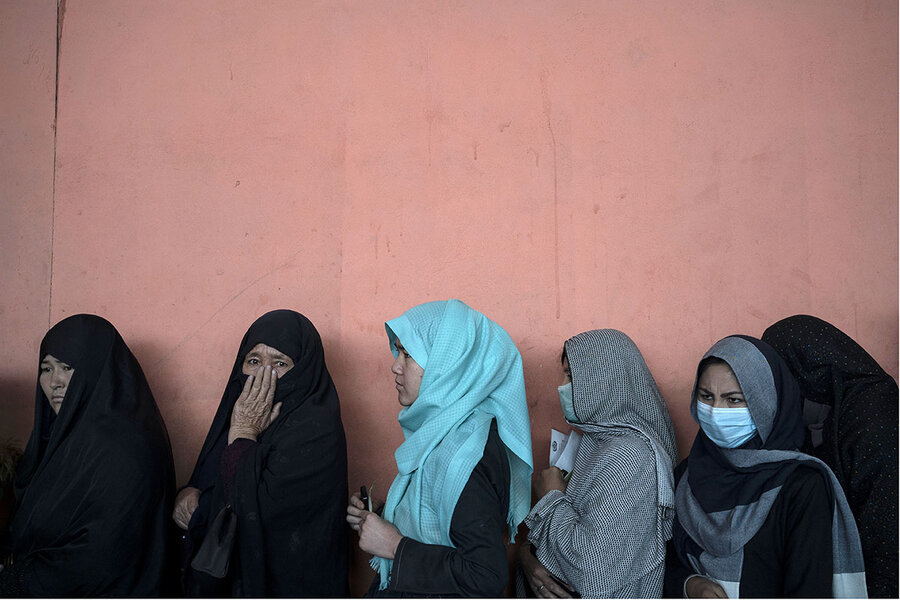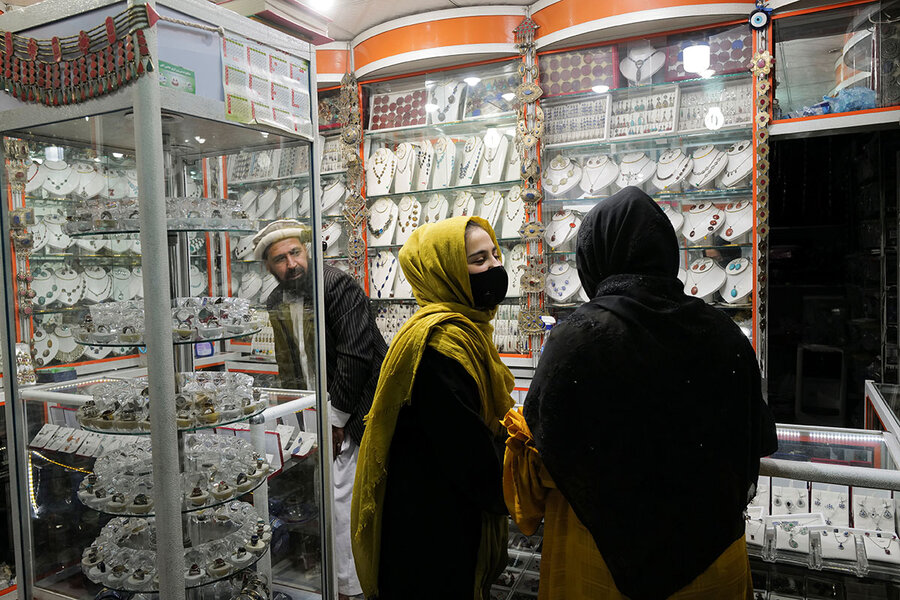Donors dilemma How to help hungry Afghans not the Taliban
There is no shortage of urgent warnings, led by the United Nations, about the looming threats this winter to the Afghan people: food insecurity for more than half the population, millions of children under 5 at risk of acute malnutrition. “A countdown to catastrophe,†in the words of David Beasley, head of the U.N. World Food Program.
Yet politicians are finding it unpalatable to resume massive Western aid to a country ruled again by the Taliban, which have been on official U.S. and European terrorist lists for years. So far, the White House has not authorized the release of $9.5 billion in Afghan Central Bank funds, most held in the U.S. Federal Reserve.
Why We Wrote ThisWinter is bringing a surge of hardship for Afghans, posing a moral dilemma for foreign aid donors leery of indirectly helping the Taliban. The urgency is compelling some to seek creative solutions.
Already Afghans who have lost jobs and homes are exhausting what savings they had. Street markets are filled to bursting, as people desperately try to sell household items for cash.
Western donors face “a vicious policy dilemma,†writes Dr. Erica Gaston at the United Nations University in a recent analysis.
Relaxing sanctions, unfreezing funds, and recognizing the Taliban “risk giving away the carrots and sticks that might otherwise be used to induce better behavior,†she writes. Yet, failure to staunch the crisis “could lead to State collapse [and] the immediate suffering of millions.â€
LONDON
With their hopes high a year ago that decades of war in Afghanistan would soon be over, they named their newborn daughter Peace.
Rafiullah Arman was a reporter for Afghan state TV, and enjoyed playing the traditional rubab lute for friends. His wife, Khalida, also worked as a journalist.
The Americans had signed a withdrawal deal with the Taliban that promised peace talks, and life was good.
Why We Wrote ThisWinter is bringing a surge of hardship for Afghans, posing a moral dilemma for foreign aid donors leery of indirectly helping the Taliban. The urgency is compelling some to seek creative solutions.
Peace has, indeed, now come. Not long ago “more than 100 funerals were held every day; no one imagined that the sound of gunfire would disappear across the country in a week,†says Mr. Arman. The aspiration in their daughter’s name has been realized.
But the lightning Taliban victory in August has also brought extreme hardship for the young family â€" as it has for millions of Afghans now facing a perfect storm of hunger, poverty, and economic meltdown as winter approaches under Taliban rule.
Mr. Arman and his wife both lost their jobs, their home, and their hope. The young family was forced to move to a tent camp in the capital before relatives found them a single, windowless room. The money they made by selling Khalida’s jewelry is already spent.
“If hunger had not prevailed after the [conflict], how grateful we would have been for the current peace,†says Mr. Arman. “But unfortunately, the slap of poverty was more powerful and stronger than war, and now we are really suffering.â€
That story of overnight transformation â€" from relative comfort to life-endangering vulnerability â€" echoes across a country that for two decades has depended on tens of billions of dollars in American and Western aid, which accounted for up to 75% of public spending. That cash has all but stopped flowing since the Taliban takeover.
As a result, a critical decision is now looming: Should the United States and Western donors provide aid â€" and indirectly help the Taliban regime consolidate power â€" or stand by and watch Afghan citizens suffer potentially catastrophic consequences?
“If we do nothing, Afghanistan drifts into state collapse. The economic chokehold is squeezing the air out of the economy,†says Graeme Smith, senior consultant for Afghanistan for the International Crisis Group (ICG).
“Temperatures are dropping below [freezing], and Afghans can’t stay warm,†he says. “People will freeze to death. And unfortunately, the experience in some other settings is that a disaster has to be visible before it gets solved. That’s the risk here.â€
A “humanitarian-plus†strategyThe danger of state collapse is so great that some donors â€" led by the Europeans, who fear a wave of fleeing migrants â€" are trying to expand stopgap emergency measures to find creative ways to alleviate the financial challenge faced by the central Taliban government in Kabul.
“Now the conversation is shifting much more toward … keeping the electricity on and paying salaries for teachers, which are not usually associated with emergencies,†says Mr. Smith. “The line between humanitarian aid and development is blurring, and it’s that blurriness that some European donors are trying to squeeze through now, with what they call a ‘humanitarian-plus’ strategy.â€

Bram Janssen/AP
Women wait in a line to receive cash at a money distribution organized by the World Food Program in Kabul, Afghanistan, Nov. 3, 2021. With winter approaching, Afghanistan is faced with harrowing predictions of growing poverty and hunger.
“There’s a prestige issue, too,†he adds. “If the world lets Afghans starve … it just compounds the shame of the chaotic exit for the international community.â€
There is no shortage of warnings, led by the United Nations, about how nearly 23 million Afghans â€" more than half the population â€" face acute food insecurity, with 3.2 million children under 5 at risk of acute malnutrition.
“We are on a countdown to catastrophe,†David Beasley, head of the U.N. World Food Program, said last week.
“It is a matter of life or death,†Qu Dongyu, head of the U.N. Food and Agriculture Organization, warned. “It is urgent that we … speed up and scale up our delivery in Afghanistan before winter cuts off a large part of the country, with millions of people … going hungry in the freezing winter.â€
U.S.-held funds frozenAnd yet, politicians are finding it unpalatable to resume massive Western aid to a country ruled again by the Taliban, which have been on official U.S. and European terrorist lists for years.
So far, the White House has not authorized the release of $9.5 billion in Afghan Central Bank funds, most of the money held in the U.S. Federal Reserve. The World Bank and other big donors â€" while issuing dire forecasts about the shrinking economy and suffocating lack of liquidity â€" refuse to deal with a jihadist regime not yet officially recognized by any nation.
The International Monetary Fund has blocked Taliban access to $440 million in new emergency reserves.
“The very serious nature of Taliban violations, combined with the equally serious humanitarian, economic, and security stakes of the situation, have created a vicious policy dilemma,†writes Dr. Erica Gaston, head of the Conflict Prevention and Sustain Peace program at the United Nations University, in a recent analysis.
Relaxing sanctions, unfreezing funds, and recognizing the Taliban “risk giving away the carrots and sticks that might otherwise be used to induce better behavior,†she writes.
Yet, failure to staunch the crisis “could lead to State collapse, the immediate suffering of millions, mass migration flows, and substantial economic and security ripple effects,†writes Dr. Gaston.
Rising desperationAlready, the crisis is forcing Afghans to fill street markets to bursting, as they try to sell household items for cash.
Desperation is so high that there is an increase in the number of families selling young daughters as brides, CNN reported this week, citing cases in several provinces.

Zohra Bensemra/Reuters
Afghan sisters try to sell a silver bracelet at a jewelry shop as they are running out of money, in Kabul, Afghanistan, Oct. 31, 2021.
That level of despair is familiar to Amina, a mother of six contacted by the Monitor in a camp for displaced Afghans on the northern outskirts of Kabul. Her husband’s job as a cook â€" for an Afghan charity organization in northern Baghlan province â€" disappeared when the Taliban arrived.
Drought also wiped out the cucumber farm where Amina had a job. The couple had to sell their household items so as to pay two months of debt on food and utility bills. She says she contemplated suicide, but, concerned for her children, “can’t do it.â€
She cries when discussing the coming winter, though the family this week was moved from a tent to a room in a mud brick dwelling. Amina’s oldest son, 12-year-old Omid â€" whose name means “hope†â€" earns barely 50 cents each day, washing cars along the road. Amina’s 10-year-old daughter collects wood from the street.
Get stories that
empower and uplift daily.
“If this situation continues, maybe everyone will starve to death because there is no food, there is no work, and prices have gone up a lot,†she says.
In the end, argues, Mr. Smith of the ICG, the solution lies in Washington’s hands. “At the end of the day, the U.S. is the major gatekeeper,†he points out. “This will require action by the Americans if they don’t want the state to fail.â€
0 Response to "Donors dilemma How to help hungry Afghans not the Taliban"
Post a Comment